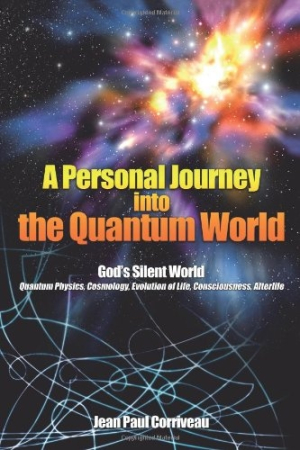A Personal Journey into the Quantum World
God's Silent World
Like James Carter’s The Living Universe and Stephen Hawking’s and Leonard Mlodinow’s The Grand Design, Jean Paul Corriveau’s A Personal Journey into the Quantum World is more than a primer on quantum physics. Through a précis of basic physics and quantum physics, he presents his own unified theory: the universe is nothing more than thoughts and energy. In his opinion, everything else is decoded by the human brain and nature, which has a kind of consciousness and intelligence.
Writing in a conversational tone and easy-to-understand language, Corriveau’s range of knowledge covers many subjects, from the definition of matter and how motion is possible to the consistent speed of light and time’s relationship with gravity. He also attempts to explain the afterlife, ghosts, creative design, and God—topics that most scientists believe to have no place in the hard sciences. Corriveau thinks differently. He writes that, “the ‘supernatural’ may not be ‘super’ at all—it may just be something beyond what humans can understand… . Maybe quantum mechanical waves and fields are the physical portal to the spiritual world.”
The title of each chapter is in the form of a question. For example, “What is Matter?” and “What is Space?” The content of each chapter answers the question posed with easy-to-understand diagrams, mathematical equations, analogies, and scientific facts. Corriveau provides an index and six carefully constructed appendices that reiterate his ideas and elucidate his supporting materials.
It is apparent that Corriveau has researched the majority of his material on the Internet, as he includes the addresses of some of the websites he has visited. Unfortunately, his failure to include proper footnotes and a bibliography mar the credibility of his research and may cause his work to be overlooked by mainstream scientists. Granted, many of the ideas he presents are original, so finding published support for them may be difficult. He claims that his book received a stamp of approval from a few scientists who reviewed the manuscript.
Corriveau’s book is also marred by typos. For example, in chapter ten, “Is There an Afterlife,” he writes that, “The devil is the abiss, and has no consciousness, which means the devil is void of purpose.” If something as simple as a misspelling of “abyss” is overlooked during the editing process, then the accuracy of the scientific information and mathematical equations might also be questioned.
The six appendices detail his calculations, but sometimes the basis for his theory goes unexplained. For example, he repeatedly describes nature as an entity with a consciousness that observes matter and senses energy, but he never actually explains how nature can observe anything. He writes that, “Nature masks the real universe from us because nature has to interpret what it feels… . Nature and our brains let us see one universe, but that implies there’s another one deeply hidden! What’s the constitution of that hidden universe? You can be sure that it is quite different from what we perceive in our daily lives.”
Despite a few typos, the absence of footnotes and a bibliography, and some moments of Ray Bradbury-like personifications of nature, Corriveau’s thoughts are new and exciting. Further experimentation may prove that there’s something to his theory.
Reviewed by
Lee Gooden
Disclosure: This article is not an endorsement, but a review. The publisher of this book provided free copies of the book and paid a small fee to have their book reviewed by a professional reviewer. Foreword Reviews and Clarion Reviews make no guarantee that the publisher will receive a positive review. Foreword Magazine, Inc. is disclosing this in accordance with the Federal Trade Commission’s 16 CFR, Part 255.

